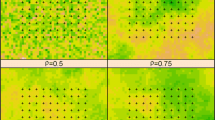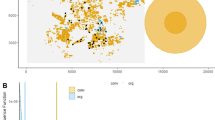Abstract
Precise knowledge about factors influencing the habitat suitability of a certain species forms the basis for the implementation of effective programs to conserve biological diversity. Such knowledge is frequently gathered from studies relating abundance data to a set of influential variables in a regression setup. In particular, generalised linear models are used to analyse binary presence/absence data or counts of a certain species at locations within an observation area. However, one of the key assumptions of generalised linear models, the independence of observations is often violated in practice since the points at which the observations are collected are spatially aligned. In this paper, we describe a general framework for semiparametric spatial generalised linear models that allows for the routine analysis of non-normal spatially aligned regression data. The approach is utilised for the analysis of a data set of synthetic bird species in beech forests, revealing that ignorance of spatial dependence actually may lead to false conclusions in a number of situations.
Similar content being viewed by others
References
Augustin NH, Mugglestone MA, Buckland ST (1998) The role of simulation in modelling spatially correlated data. Environmetrics 9: 175–196
Augustin NH, Kublin E, Metzler B, Meierjohann E, von Wühlisch G (2005) Analyzing the spread of beech canker. Forest Sci 51: 438–448
Banerjee S, Carlin BP, Gelfand AE (2004) Hierarchical modelling and analysis for spatial data. Chapman and Hall/CRC Press, Boca-Raton
Brezger A, Kneib T, Lang S (2005) BayesX: analysing Bayesian structured additive regression models. J Stat Software 14(11):1–22
Bühlmann P, Hothorn T (2008) Boosting algorithms: regularization, prediction and model fitting. Stat Sci (to appear)
Czech B, Trauger D, Farley J, Costanza R, Daly H, Hall C, Noss R, Krall L, Krausman P (2005) Establishing indicators for biodiversity. Science 308: 791–792
Diggle PJ, Ribeiro PJ Jr. (2006) Model-based geostatistics. Springer, New York
Diggle PJ, Moyeed RA, Tawn JA (1998) Model-based geostatistics. Appl Stat 47: 299–350
Eilers PHC, Marx BD (1996) Flexible smoothing using B-splines and penalties (with comments and rejoinder). Stat Sci 11: 89–121
Fahrmeir L, Tutz G (2001) Multivariate statistical modeling based on generalized linear models. Springer, New York
Fahrmeir L, Kneib T, Lang S (2004) Penalized structured additive regression: a Bayesian perspective. Stat Sinica 14: 731–761
Finley AO, Banerjee S, McRoberts RE (2007) A Bayesian approach to multi-source forest area estimation. Environ Ecol Stat (to appear)
Gotway CA, Stroup WW (1997) A generalized linear model approach to spatial data analysis and prediction. J Agric Biol Environ Stat 2: 157–178
Griffith DA (2002) A spatial filtering specification for the auto-Poisson model. Stat Probabil Lett 58: 245–251
Griffith DA (2004) A spatial filtering specification for the autologistic model. Environ Plan A 36: 1791–1811
Griffith DA (2005) Effective geographic sample size in presence of spatial autocorrelation. Ann Assoc Am Geogr 95: 740–760
Griffith DA, Peres-Neto PR (2006) Spatial modelling in ecology: the flexibility of eigenfunction spatial analyses. Ecology 87: 2603–2613
Hastie T, Tibshirani R (1990) Generalized additive models. Chapman and Hall, Boca Raton
Hoeting JA, Leecaster M, Bowden D (2000) An improved model for spatially correlated binary responses. J Agric Biol Environ Stat 5: 102–114
Hothorn T, Bühlmann P (2006) mboost: model-based boosting, R package version 0.4-9. http://CRAN.R-project.org/
Huffer FW, Wu H (1998) Markov chain Monte Carlo estimation for autologistic regression models with application to the distribution of plant species. Biometrics 54: 509–524
Hurlbert SH (1984) Pseudoreplication and the design of ecological field experiments. Ecol Monogr 54: 187–211
Jaksic FM, Medel RG (1990) Objective recognition of guilds: testing for significant species clusters. Oecologia 82: 87–92
Keitt TH, Bjornstad ON, Dixon PM, Citron-Poussy S (2002) Accounting for spatial pattern when modeling organism-environment interactions. Ecography 25: 616–625
Kneib T, Fahrmeir L (2006) Structured additive regression for categorical space-time data: a mixed model approach. Biometrics 62: 109–118
Krebs JC (1999) Ecological methodology, 2nd edn. Harper Collins, New York
Lang S, Brezger A (2004) Bayesian P-splines. J Comput Graph Stat 13: 183–212
Latimer AM, Wu S, Gelfand AE, Silvander JA (2006) Building statistical models to analyze species distributions. Ecol Appl 16: 33–50
Legendre P (1993) Spatial autocorrelation: trouble or new paradigm. Ecology 74: 1659–1673
Midgarden DG, Youngman RR, Fleischer SJ (1993) Spatial analysis of counts of western corn rootworm (Coleoptera: Chrysomelidae) adults on yellow sticky traps in corn: geostatistics and dispersion indices. Environ Entomol 22: 1124–1133
Mosimann P, Naef-Daenzer B, Blattner M (1987) Die Zusammensetzung der Avifauna in typischen Waldgesellschaften der Schweiz. Der Ornithol Beobachter 84: 275–299
Müller J (2005a) Bird communities as indicators for woodland structures in oak woods. Der Ornithol Beobachter 102: 15–32
Müller J (2005b) Forest structures as key factor for beetle and bird communities in beech forests. Dissertation at the Munich University of Technology. http://mediatum.ub.tum.de
Nychka D (2000) Spatial-process estimates as smoothers. In: Schimek M(eds) Smoothing and regression: approaches, computation and application. Wiley, New York
Perry JN, Liebhold AM, Rosenberg MS, Dungan J, Miriti M, Jakomulska A, Citro-Pousty S (2002) Illustrations and guidelines for selecting statistical methods for quantifying spatial pattern in ecological data. Ecography 25: 578–600
Pinheiro J, Bates D (2000) Mixed effects models in S and S-Plus. Springer, New York
Pinheiro J, Bates D, DebRoy S, Sarkar D, the R Development Core Team (2007). nlme: linear and nonlinear mixed effects models. R package version 3.1-85. URL http://CRAN.R-project.org/
Primack R (2004) A primer of conservation biology. Sinauer Associates Inc
Purroy FJ (1974) Breeding communities of birds in the beech and fir forests of the Pyrenees. Acta Ornithol 20: 151–157
Ripley B (1990) Gibbsian interaction models. In: Griffith DA(eds) Spatial statistics: past, present and future. IMAGE, Ann Arbor
R Development Core Team (2006) R: a language and environment for statistical computing. R Foundation for Statistical Computing, Vienna, Austria. URL http://www.R-project.or. ISBN 3-900051-07-0
SAS/STAT software, Version 9 (2007) SAS Institute Inc., Cary, NC. URL http://www.sas.com/
Schabenberger O, Gotway CA (2004) Statistical methods for spatial data analysis. Chapman and Hall/CRC Press, Boca Raton
Scherzinger W, Schumacher H (2004) Effects of forest management on forest-dwelling birds – a review. Vogelwelt 125: 215–250
Simberloff D, Dayan T (1991) The guild concept and the structure of ecological communities. Annu Rev Ecol Syst 22: 115–143
Spiegelhalter DJ, Best NG, Carlin BP, van der Linde A (2002) Bayesian measures of model complexity and fit (with discussion). J R Stat Soc Ser B 64: 583–616
Stephenson CM, MacKenzie ML, Edwards C, Travis JMJ (2005) Modelling establishment of an exotic plant, Rhododendron ponticum, invading a heterogenous, woodland landscape using logistic regression with spatial autocorrelation. Ecol Model 193: 747–758
Tilman D, Knops J, Weldin D, Reich P, Ritchie M, Sieman E (1997) The influence of functional diversity and composition on ecosystem processes. Science 277: 1300–1302
Underwood AJ (1981) Techniques of analysis of variance in experimental marine biology and ecology. Oceanogr Mar Biol Annu Rev 19: 513–605
Utschick H (2004) Saisonale Veränderungen der Raumnutzungsmuster von mittelschwäbischen Waldvogelzönosen. Ornithol Anzeiger 43: 19–48
Wilson EO (1992) The diversity of life. Belknap Press, Cambridge
Wintle BA, Bardos DC (2006) Modeling species-habitat relationships with spatially autocorrelated observation data. Ecol Appl 16: 1945–1958
Wood SN (2003) Thin plate regression splines. J R Stat Soc B 65: 95–114
Author information
Authors and Affiliations
Corresponding author
Rights and permissions
About this article
Cite this article
Kneib, T., Müller, J. & Hothorn, T. Spatial smoothing techniques for the assessment of habitat suitability. Environ Ecol Stat 15, 343–364 (2008). https://doi.org/10.1007/s10651-008-0092-x
Received:
Revised:
Published:
Issue Date:
DOI: https://doi.org/10.1007/s10651-008-0092-x




